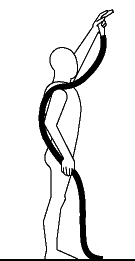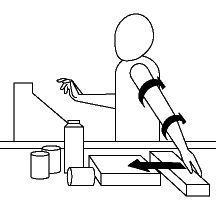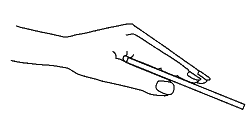Work-related Musculoskeletal Disorders (WMSDs) - Risk Factors
On this page
- What are the risk factors for work-related musculoskeletal disorders (WMSDs)?
- How are awkward and static postures a risk for WMSDs?
- How do repetitiveness and pace of work influence WMSDs?
- What should I know about forceful movements and heavy loads?
- How does vibration encourage WMSDs?
- How does temperature affect WMSDs?
- How do psychosocial hazards affect WMSDs?
What are the risk factors for work-related musculoskeletal disorders (WMSDs)?
Back to topWork-related musculoskeletal disorders (WMSDs) are associated with these factors:
- Awkward and static postures.
- Repetitiveness and pace of work.
- Forceful movements and heavy loads.
- Vibration.
- Temperature.
- Lack of influence or control over one's job.
- High work demands.
- Lack of or poor communication.
- Monotonous tasks.
- Perception of low support (e.g., from manager or co-worker).
Both physical and psychosocial factors can contribute to WMSDs and should be controlled in the workplace.
For more information about WMSDs in general, please see our OSH Answers document Work-related Musculoskeletal Disorders (WMSDs).
How are awkward and static postures a risk for WMSDs?
Back to topAny body position can cause discomfort and fatigue if it is maintained for long periods of time. Standing, for example, is a natural body posture and poses no particular health hazards. However, working for long periods in a standing position can cause sore feet, general muscular fatigue, and lower back pain. In addition, improper layout of work areas and certain tasks can make workers use unnatural standing positions.
Two aspects of posture can contribute to injuries. The first relates to body position. When body parts are near the extremes of their range of movements, stretching and compression of tendons and nerves occur. The longer a fixed or awkward body position is used, the more likely a worker is to develop WMSDs. For example, working with the torso bent forward (Figure 1), backward, or twisted can place too much stress on the lower back. Other examples of stressful body positions include reaching above shoulder level (Figure 2), reaching behind the body (Figure 3), rotating the arms (Figure 4), bending the wrist forward, backward, or side to side (Figure 5), and reaching forward too far out in front of the body (Figure 6).
The second aspect that contributes to WMSDs is holding the neck and shoulders in a fixed position. To perform any controlled movement with the arm, muscles in the shoulder and neck contract and stay contracted for as long as the task requires.
The contracted muscles squeeze the blood vessels, restricting the flow of blood all the way down to the working muscles of the hand.
However, this is where the blood is needed the most because of the intense muscular effort. Two things happen as a result. The neck/shoulder muscles become overtired even though there is little or no movement. At the same time, the reduced blood supply to the rest of the arm accelerates fatigue in the moving muscles, making them more prone to injury.






How do repetitiveness and pace of work influence WMSDs?
Back to topRepetitive movements are especially hazardous when the same joints and muscle groups are used to perform repeated motions too often, too quickly, and for too long. Tasks requiring repetitive movements often involve other risk factors for WMSD, such as fixed body position and force.
To analyze how repetitive a task is, we need to describe it in terms of steps or cycles. For example, the bottle packing operation (Figure 7) requires workers to pack boxes with twenty-four bottles.

One cycle can be described as follows:
- Reach for bottles.
- Grasp bottles.
- Move bottles to box.
- Place bottles in box.
If a worker grasps four bottles each time, the same cycle would have to be repeated six times to fill a box. Assuming that one cycle lasts two seconds, it would take twelve seconds to pack a box with twenty-four bottles.
There are no rules to judge movements as either high or low in repetition. Some researchers classify a job as "high repetitive" if the time to complete such a job is less than 30 seconds or "low repetitive" if the time to complete the job is more than 30 seconds. Although no one really knows at what point WMSDs may develop, workers performing repetitive tasks are at risk for WMSDs
Work involving movement repeated over and over is very tiring because the worker cannot fully recover in the short periods of time between movements. Eventually, it takes more effort to perform the same repetitive movements. When the work activity continues in spite of the fatigue, injuries can occur.
The pace of work determines the amount of time available for rest and recovery of the body between cycles of a particular task. The faster the pace, the less time is available and the higher the risk for WMSDs.
When the worker has no control over the timing and speed of work because of external factors like assembly line speed or quota systems, stress levels increase. With higher stress levels come muscle tension, causing fatigue and, again, increased risk for WMSDs. Controlling the pace of work externally denies the worker the flexibility to determine their own work speed. It is a human characteristic to work at varying rates at different times of the day.
What should I know about forceful movements and heavy loads?
Back to topForce is the amount of effort our bodies must do to lift objects, to use tools, or to move.
More force equals more muscular effort, and consequently, a longer time is needed to recover between tasks. Since there is not sufficient time for recovery during repetitive work, the more forceful movements develop fatigue much faster. Exerting force in certain hand positions is particularly hazardous (Figures 8A-8F).






The amount of force we use to do a job depends on many factors, such as the weight of the objects and their placement in relation to the body. It requires more force to lift and carry a box with arms outstretched and held away from the body (Figure 9A) or to lift the same objects in a "pinch" position (Figure 9B) than in a "hook" position (Figures 10A, 10B).




The shape of the tool also plays an important role. Tools that do not allow a neutral position of the wrist, elbow, and shoulder substantially increase the force required. Worn and poorly maintained tools are also very important yet often overlooked. For example, a worn screwdriver, pliers with worn jaws, or dull scissors can increase the operating force by tenfold.
Although no one really knows when WMSDs will develop, workers performing forceful movements are at risk. Work involving forceful movements is very tiring again because there is not enough time for a full recovery between movements. Eventually, it takes more effort to perform the same task. When the work activity continues in spite of the developing fatigue, injuries occur.
How does vibration encourage WMSDs?
Back to topVibration affects tendons, muscles, joints, and nerves. Workers can be exposed to whole-body vibration or localized vibration.
Whole-body vibration is experienced by truck and bus drivers, for example. Localized vibration exposure can be caused by power tools. Common symptoms are numbness of the fingers, loss of touch and grip, and pain. In addition, the worker may use more force and awkward body positions because vibration hand tools are harder to control.
Exposure to too much vibration can also cause workers to lose the feeling in their hands and arms. As a result, workers may misjudge the amount of force they need to control the tools and use too much, which increases fatigue.
How does temperature affect WMSDs?
Back to topIn general, when it is too cold, or when workers touch cold materials, their hands can become numb. With numbed hands, they are more likely to misjudge the amount of force needed to do their work and use too much. A cold environment also makes workers' bodies less flexible. Every movement workers make, and every position they hold takes a lot more work, and then WMSDs are more likely to develop.
When it is too hot and too humid, workers tire more quickly and may become more susceptible to injury.
How do psychosocial hazards affect WMSDs?
Back to topHazards such as lack of influence or control over one's job, high work demands, poor communication, and monotonous (boring) tasks can negatively impact workers' mental health. Hazards that affect mental health can be grouped into thirteen psychosocial factors. Employers should assess the workplace for hazards in each psychosocial factor and implement appropriate control measures.
Psychological stress at work can also cause physiological changes, which in turn can result in WMSDs. For example, a stressed worker may have increased muscular tension, resulting in excessive force during certain activities. As discussed above, this increase in force may result in WMSDs.
Learn more about how psychosocial factors can result in WMSDs by reading the OSH Answers fact sheet Musculoskeletal Disorders - Psychosocial Factors.
- Fact sheet last revised: 2024-07-10
